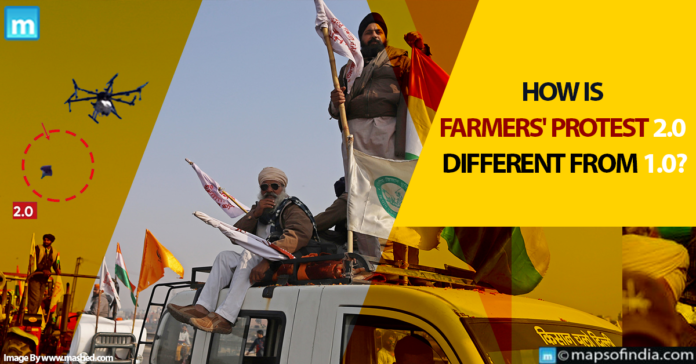In 2024, India witnessed the resurrection of farmer protests, known as “Farmers’ Protest 2.0”. After a two-year pause, farmers have started the protest again. While this second movement also shares concerns with the 2020-21 agitation, it differs significantly regarding demands, participants, and leadership. Understanding these differences is essential for assessing the changing landscape of Indian agriculture and the challenges encountered by its backbone – farmers.
Demands
Farmers’ Protest 1.0
Farmers condemned the three farm laws enacted by the government in 2020-21 due to various issues. First, they were concerned about being exploited by private corporations if they were allowed to trade outside of the Agricultural Produce Market Committee (APMC) mandis and engage in contracts, fearing that large corporations would dictate pricing and terms to their detriment. Furthermore, there were concerns about the weakening of the current APMC mandi system, which had long supplied farmers with a regulated market and guaranteed acquisition of their produce at Minimum Support Prices (MSP). The lack of a legal guarantee for MSP heightened their concerns, making them subject to market changes and price instability.
Farmers’ Protest 2.0
The present farmers’ protest, which includes over a dozen demands, focuses on obtaining a legal guarantee for the Minimum Support Price (MSP) for all crops, a demand raised in prior protests. The MSP, set by the government twice a year based on recommendations from the Commission for Agricultural Costs and Prices, primarily benefits wheat and rice farmers in Punjab and Haryana, supporting the public distribution system. Farmers demand legislation to guarantee MSP for all crops and lobby for adopting the MS Swaminathan committee’s recommendations, which include boosting MSP to at least 50% above the weighted average cost of production. Other demands include:
- Better sugar cane prices.
- A monthly pension of Rs 10,000 for farmers aged 60 and up.
- More significant repercussions for those engaged in the Lakhimpur Kheri tragedy.
- The allotment of land in Delhi for a memorial to the preceding protest’s “martyrs”.
Leadership and Participation
Farmers Protest 1.0
The 2020-21 farmers’ protest was led by a coalition of farmer unions and organizations, with prominent leaders including those from the All India Kisan Sangharsh Coordination Committee (AIKSCC), Bharatiya Kisan Union (BKU) factions led by figures like Rakesh Tikait and Naresh Tikait, the Kisan Mazdoor Sangharsh Committee (KMSC), mainly active in Punjab, and the Rashtriya Kisan Mahasangh (RKM), alongside numerous regional farmer unions from states such as Punjab, Haryana, and Uttar Pradesh.
Farmers Protest 2.0
The current protests are led by a splinter group of the umbrella organization, Sanyukt Kisa Morcha (SKM). This side, called the Sanyukt Kisan Morcha (non-political), excludes some renowned farmer leaders who were key protagonists in past uprisings, including Darshan Pal, Joginder Singh Ugrahan, Rakesh Tikait, Balbir Singh Rajewal, and Gurnam Singh Charuni. Instead, SKM (non-political) comprises organizations such as BKU (Dallewal), led by Jagjit Singh Dallewal, and Kisan Mazdoor Morcha, led by Sarvan Singh Pandher, who claim support from 17 agricultural organizations. Pandher, Dallewal, and Abhimanyu Kohar of Haryana have emerged as the most visible SKM (non-political) personalities.




